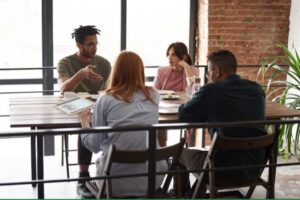Since the release of the Eastside Pathways Equity Pledge (EPEP) there have a lot of questions about what “not signing in isolation” looks like. While there are many schools of thought around who, how, when, where, and why facilitation should take place, we believe facilitation is a critical piece of an equitable collaborative process.
 Within the Eastside Pathways’ Collaborative Action Networks (CANs) facilitators, staff, and volunteers support stakeholders in a wide variety of ways including:
Within the Eastside Pathways’ Collaborative Action Networks (CANs) facilitators, staff, and volunteers support stakeholders in a wide variety of ways including:
- Growing a “coalition of the willing” defined as stakeholders committed to working together long enough to create change
- Establishing a shared understanding of who is at the table, who is missing, why, and what might be needed in order for the “right” stakeholders to be at the table
- Identifying and adapting leadership structure(s) such as power dynamics and inequities
- Drawing attention to, and developing shared language, goals, indicators and values
- Offering a toolkit to move from talk to action bringing together multiple perspectives working towards a common goal
- Providing a culture of accountability, follow-up, and follow through from developing to implementing adaptive solutions/strategies that last
 When it comes time for you to host a collaborative signing process of the EPEP, and/or managing conflict and modify in your area of focus, Eastside Pathways Backbone’s Community Impact Managers Sandy Nathan and Kalika Curry recommend using the following frameworks to design your space:
When it comes time for you to host a collaborative signing process of the EPEP, and/or managing conflict and modify in your area of focus, Eastside Pathways Backbone’s Community Impact Managers Sandy Nathan and Kalika Curry recommend using the following frameworks to design your space:
Gracious Space and Working Agreements
- Gracious Space: Being intentional about creating a safe space for stakeholders to have honest conversations. Intentional time in the agenda to focus on relationships. An opportunity for stakeholders to feel centered, grounded, and ready to do the work.
- For example: an intentional check-in question at the beginning of a meeting that will get every participant’s mind and body centered to move towards the results of the meeting
- Working Agreements: An invitation to co-develop the culture of the space with stakeholders so each person can have what they need to participate authentically in moving the work forward
- For example: Making sure the group is aligned on the diverse needs of each participant and willing to support an agreement/requirement even if they might not have that need. Need for the agenda to be sent out at least a week prior to the meeting or need for meetings to not be held in the afternoons after 3 pm for a parent working from home.
Cultural Competency and Historical Context
- Cultural Competency – Not to be confused with racial equity or racism, this is about the food, fabrics, customs, etc. of different groups. What makes them feel comfortable? What is taboo?
- For example: Is making eye contact seen as a sign of respect or disrespect? Amongst whom? When?
- Historical Context – This is where you begin to understand all of the –isms. How has this group been treated historically and does that impact them today?
 Decision-making, Communication & Learning Styles
Decision-making, Communication & Learning Styles
- Meyers Briggs (MBTI) is one example of a framework to understand how people process information and makes decisions. Adopting and using a model that works well for your group is a huge step in having shared understanding and accountability for the efficacy of your group’s collaboration.
- For example: Some staff members prefer precise data, Sensor (S), in order to make decision whereas others may rely on intuition, Intuitive (N).
- Decision-making culture and rules, especially the unwritten ones, have a huge impact on the process and progress groups make while working to create change. Naming and modifying these rules is a great place to begin adapting your environment.
- For example: Ageism might be embedded implicitly in your decision-making. Identifying areas for youth to make decisions from start to finish would be change to those norms.
3R’s
- Results:
- For example: Keeping the end results and/or “end user” at the center of your results in mind is a big part of our model. Because we believe that centering those most impacted is foundational to creating change, by including and focusing on their lived experiences and expertise we can rewire our policies and practices for better outcomes.
- Reviewing the relationship that each stakeholder has to the result helps establish a shared understanding of “what’s in it for me”, “why do I need to be on the table”, “why is there a need for others to be on the table”- a balance between those who have the authority and those that are closest to the results to work together to move towards the collective result
- Relationships: The tenor of a person(s) experience with other people (interpersonal), groups and/or organizations (institutional).
- For example: If you have a mix of new staff, with little to no institutional knowledge, working with seasoned staff there is an information equity gap that changes how productive the group is. This may also include intergenerational experiences that influences people’s emotions towards a process, practices, or systems structure e.g. education.
- Roles & Responsibilities: Understanding the formal and informal authority to implement a task or strategy is mission critical. This can be addressed in number of ways, most often it looks like inviting the “right” people and/or shifting power where it doesn’t already exist e.g. changing the roles and authority of people not traditionally in your rooms
- For example: A shelter might already prep a unit for the new residents or they might develop a process for those residents to choose the items they want to use in their space.

